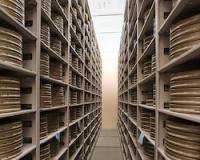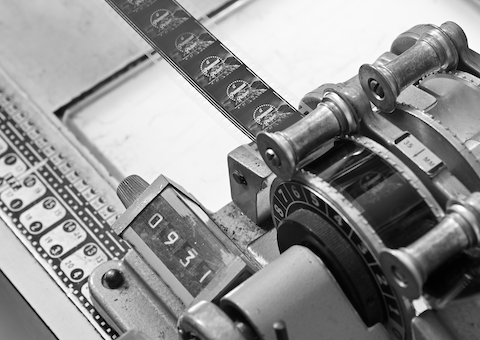
A strip of film placed through a synchronizer.
For this year’s Ask an Archivist Day, we’re revisiting some of the questions that have been asked in previous years by our followers on Twitter, Instagram and Facebook — from our oldest holdings to “holy grails” and what makes this work so special.
What are some ways to get involved in moving image archiving and/or pursue a career in the field?
Mark Quigley, John H. Mitchell Television Curator: I would suggest that professionals interested in working in moving image archives become involved in the Association of Moving Image Archivists (AMIA). AMIA provides excellent opportunities to get to know the field and the people working in it. Education programs in moving image archive studies (such as the Media Archival Studies concentration at the UCLA School of Education and Information Studies) have generated a very talented pool of graduates that are attractive applicants for open posts, so continuing your education is a good path.
Miki Shannon, Senior Film Preservationist: In addition to coursework, graduate school affords students with the opportunity to intern at studios, labs and a variety of archives to gain experience that can translate to skills in your area of interest.
Staci Hogsett, Head of Collections: The International Federation of Film Archives (FIAF), National Film Preservation Foundation and other organizations often have great resources for those interested in learning more about the field. Our student interns in the Collection Services department come from a wide range of backgrounds and we’re always happy to teach the skills needed.
Todd Wiener, Motion Picture Curator: Also, attend archival symposia and events (like the L.A. Archives Bazaar, Orphan Film Symposium, and your local Home Movie Day, which is an opportunity to volunteer) and screenings with archivist Q&As, etc.
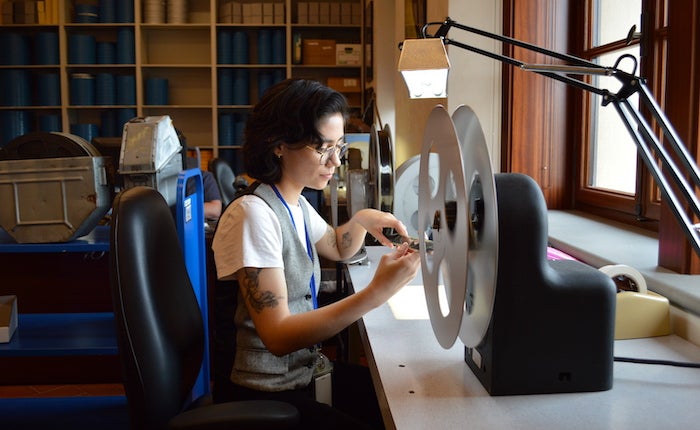
UCLA Media Archival Studies graduate Yesenia Perez received training in the Collection Services department through a student internship.
What is the oldest record in your collection?
Jeffrey Bickel, Senior Newsreel Preservationist: The oldest item that exists in the Hearst newsreel collection is a silent newsreel story from 1915 from the Hearst-Selig News Pictorial series. It is a WWI story of a German spy, Capt. Werner Vanhorne, who bombed an important railroad line bridge in Vanceboro, Maine, which connected Canada and the U.S. The bomb damaged the bridge, but it did not destroy it, and Capt. Vanhorne was caught, convicted and served six years in prison.
Mark: The Archive's television collection has numerous programs from 1948. One of the most interesting early titles is a deposited kinescope excerpt of The Bob Howard Show, one of the earliest network programs hosted by an African American.
Staci: The oldest confirmed item we have in our collection, overall, is nitrate film of President William McKinley’s funeral from 1901. The Archive also conserves modern film copies of 1890s shorts that survive as paper prints at the Library of Congress.
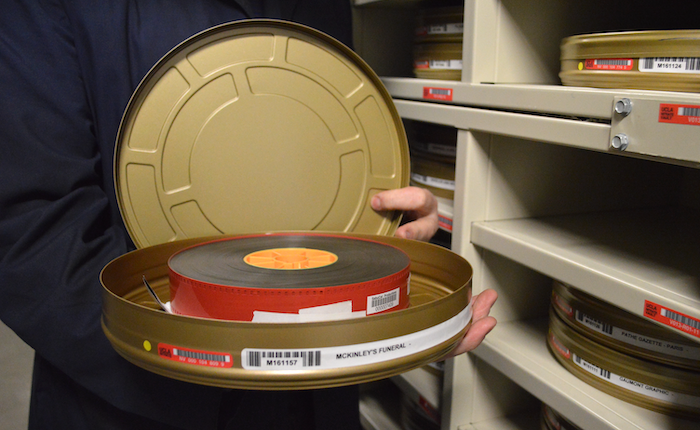
A nitrate reel from 1901 that depicts President William McKinley’s funeral.
What’s the most amazing thing you “found” in the archive that was hiding in plain sight for years?
Mark: An interesting recent find for me is one that we screened online in October 2020 — The Classic Ghosts: “The Screaming Skull.” A 2 inch videoreel master of the show, and other episodes in the series, were in our collection for many years, mostly uncatalogued. Upon researching the title (a few years ago now) I found that, in an anomaly for 1973, the horror telefilm had a high number of women working on the production, as directors, producers, grips and much more. That coupled with the fact that it was shot on videotape for late night TV, made it a fun and important find — one we were eager to share.
Todd: A personal favorite was the discovery of a very early trans subject short film titled Changes (1970) by Pat Rocco. The complete film had been dismantled into separate sections for use in different compilations, and the filmmaker had totally forgotten he had made it. Our Digital Lab team did a valiant job rescuing this rare and heavily damaged short film.
Watch Changes (1970) on our YouTube channel:
What’s the most precious film/reel you personally helped save?
Jillian Borders, Head of Preservation: The most meaningful project for me was working on Superstar: The Karen Carpenter Story (1987) by Todd Haynes. I had only seen the film from bootleg VHS copies, so to be able to preserve it from the original elements was really exciting. We are working on another title now, The Sealed Soil (dir. Marva Nabili, 1977), which has also only been available on inferior sources, but we are fortunate to be able to restore from the original deteriorating negatives before it is too late.
Mark: One of the most precious reels I’ve encountered is a rare 16mm kinescope that had been sitting on a donor’s porch for several decades with a slew of other, mostly unremarkable prints. The lone gem was a CBS closed circuit presentation for the press from 1956, announcing a new anthology premiering that season — Playhouse 90. Never broadcast, the presentation includes John Frankenheimer, Charlton Heston, Kim Hunter, Boris Karloff, Peter Lorre, Rod Serling, Ed and Keenan Wynn and many others. We have since preserved the reel and created a new 35mm negative and exhibition print.
Miki: The most disturbing images I have ever worked on have been the footage shot by various countries in the WWII concentration camps. The idea that anyone could ever think the Holocaust never happened astounds me. It has always been important to me that I was able to have a hand in ensuring these films will always be available for future generations to see.
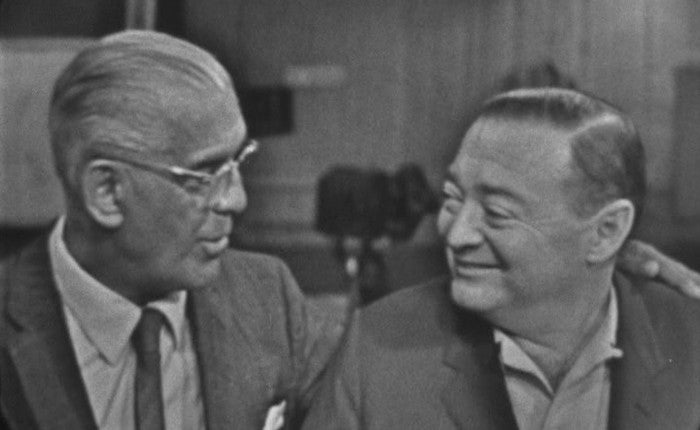
Boris Karloff and Peter Lorre on Playhouse 90—CBS Closed Circuit Presentation (1956).
What’s currently considered the surest, most durable preservation medium for motion pictures?
Miki: “Durable” is the key word here. If black and white safety film stock is properly stored, it will last at least 100 years, while color film may fade. So, for color films, separation masters are created — the original color negative is used to create three black and white master positives, each one filtered for one of the RGB spectrums — for long-term preservation.
While it is important to preserve films digitally, given the advancement of clean-up tools, the formats for this are in flux and in constant need to be upgraded and maintained. Ideally, both methods should be employed.
What is the process of choosing which films to preserve? What does the process and timeline for restoration look like, in terms of stages and years?
Jillian: The Archive makes preservation determinations based on a number of factors, including the condition of the elements, if the title is at risk of being lost, copyright status, funding opportunities and current relevance. Most of our projects are grant-funded, so the ability to raise the needed budget is a huge consideration when choosing projects. Sometimes, issues beyond our control will put a project on hold, including the inability to get needed film elements, funding shortages or technical difficulties. At the minimum we try to at least preserve the elements that we have for safe-keeping (by scanning or copying onto new film stock) even if a large-scale restoration isn’t feasible at the moment.
Sometimes everything goes perfect and you can complete a project in a month, other times it can take years to accumulate all the elements and funds you need to complete a project. We usually have many projects going in various stages of completion at all times!
Todd: Our partners like Outfest, Sundance Institute and Film Noir Foundation also bring preservation/restoration projects to us that they are looking to fund for their constituencies.
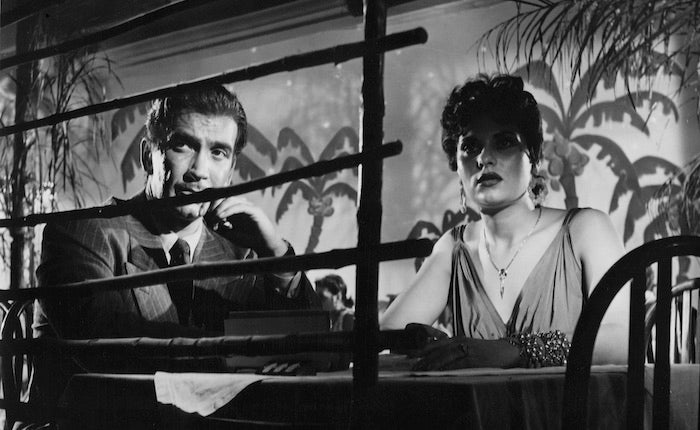
Los tallos amargos (The Bitter Stems, 1956) is one of several Argentine noirs restored by the Archive with the collaboration and support of the Film Noir Foundation. Available through Flicker Alley.
What is the process of choosing which TV programs to preserve?
Mark: For television, our preservation selection criteria is centered upon any combination of the following factors: the historic, socio-political and/or cultural significance of the content; scarcity/uniqueness of the item (e.g. not preserved elsewhere); and fragility/condition of the physical medium (e.g. deteriorating/endangered). A perfect example is the Archive’s collection of the local, independently produced African American news, information and entertainment program Tom Reed’s For Members Only. The surviving episodes of that series, which aired on UHF TV in Los Angeles from the 1980s into the 2000s, existed only on aging videocassettes that we digitized for preservation and access (with episodes available for online research in the coming year).
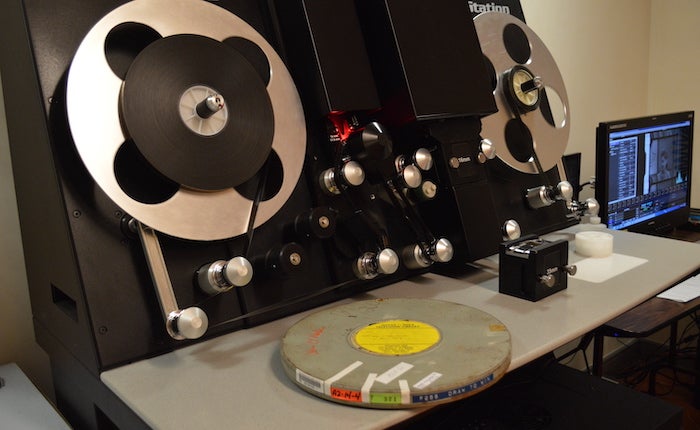
Archive Digital Lab equipment used to digitize film, including 16mm kinescopes from the television collection.
What film/TV project is your “holy grail”? The one that you hope is found before it’s too late.
Mark: I hope to locate episodes of Canción de la Raza, a Chicanx drama produced on 2 inch videotape by KCET in 1968/69. UCLA has preserved the debut episode, but none of the other 60+ episodes produced have been located. My other “holy grail” would be to locate the original 2 inch tapes of the horror anthology Way Out (CBS, 1961), as only kinescopes of the series are known to survive.
Steven K. Hill, Associate Motion Picture Curator: Silent film holy grails: while there are literally thousands of interesting silents that are currently lost, mine would be F.W. Murnau's 4 Devils (1928, starring Janet Gaynor) or Ernst Lubitsch’s Kiss Me Again (1925, starring Marie Prevost and Clara Bow).
Randy Yantek, Digital Lab Manager: Classic music/variety programs from the 1960s, such as surviving kinescopes or 2 inch tapes of missing programs from the Perry Como shows, Shindig!, Hullabaloo and others.
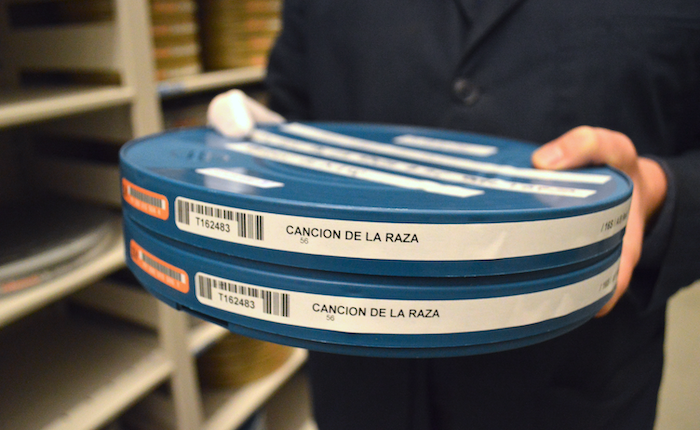
16mm A/B rolls (MOS) of footage shot for Canción de la Raza (Song of the People). Only the debut episode in known to survive in complete form, which has been preserved by the Archive from 2 inch tape.
Can anyone use the archives? Is there a fee associated with the use of archival footage for a documentary project?
Kara Molitor, Media Licensing Manager: We do have fees that we charge for accessing material from the Archive for documentaries and other productions. Clients can learn more on our Media Licensing webpage and email us with questions at footage@cinema.ucla.edu.
Maya Montañez Smukler, Archive Research and Study Center Officer: Any researcher is welcome to view material from the Archive’s collection on-site in the Archive Research and Study Center (ARSC) located on the UCLA campus in Powell Library. You can be part of the UCLA community, or a student/faculty/staff from another institution, or a member of the general public! Visits to ARSC to view collection holdings are free. Please take a look at instructions on how to plan a research visit outlined on our ARSC webpage and email ARSC with any questions at arsc@cinema.ucla.edu.
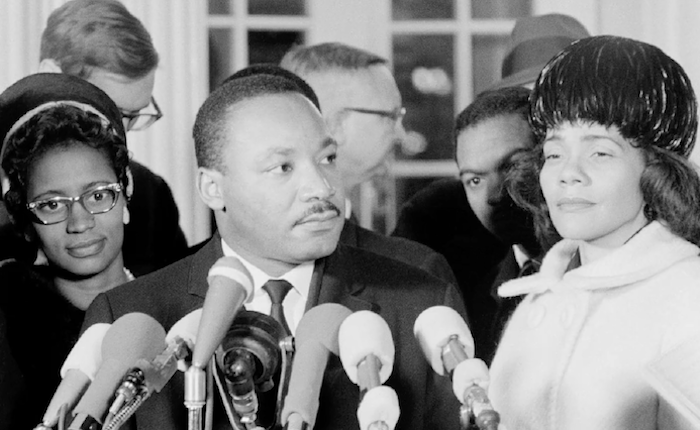
Hearst Metrotone News: “Martin Luther King visits LBJ,” also depicting Coretta Scott King (right), December 18, 1964.
What’s your favorite part about being an archivist?
Jeffrey: My favorite part of being an archivist is bringing these important newsreels, depicting 20th century life and history, to the general public. The Archive and the Packard Humanities Institute have made many of the newsreels available online through the new Hearst Metrotone News website: newsreels.net.
Jillian: The detective work is my favorite part of the job. Finding the best source material for a title, puzzling out the provenance of the film elements and deciding how to combine them for the final restoration is deeply satisfying. Then of course, making the restoration available to the public!
Mark: Preserving humanist-themed programming and the history of social justice movements.
Randy: Digitally restoring films and TV shows to the way they were originally seen. Finding 16mm kinescopes with original commercials and editing them back into TV programs for our screenings at the Billy Wilder Theater.
Staci: In Collection Services we manage the vaults and processing new acquisitions, among other things. One thing I’ve always loved about working in this department is the variety of materials that I’m presented with — whether it’s processing a collection of home movies shot in Papua New Guinea or just stumbling across interesting titles while in the vaults, there’s always something new discover!
Steven: Having the opportunity to search our vaults and other archives for rare and nearly lost films so they can be preserved and made available to audiences again — a great honor, and a whole lot of fun!
Todd: Figuring out ways to accommodate programmatic and research access, and working with all our great archival partners at fellow archives, libraries and studios.
—edited by Jennifer Rhee, Digital Content Manager
< Back to the Archive Blog






 Mobile Navigation
Mobile Navigation
